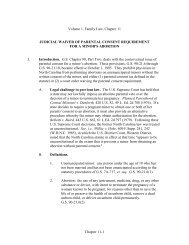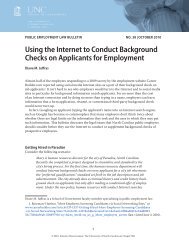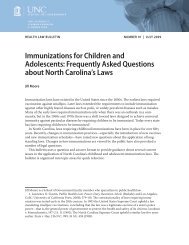Sentencing, Corrections, Prisons, and Jails - School of Government ...
Sentencing, Corrections, Prisons, and Jails - School of Government ...
Sentencing, Corrections, Prisons, and Jails - School of Government ...
Create successful ePaper yourself
Turn your PDF publications into a flip-book with our unique Google optimized e-Paper software.
232 North Carolina Legislation 1998<br />
• Overall, the auditor’s report concluded that DAPP’s programs compared favorably with<br />
other states’ programs <strong>and</strong> noted that DAPP has the reputation <strong>of</strong> being an innovator.<br />
• About 37 percent <strong>of</strong> probationers <strong>and</strong> parolees are rearrested <strong>and</strong> charged with a new<br />
crime within an average follow-up period <strong>of</strong> thirty-five months. This finding was based<br />
on research by the <strong>Sentencing</strong> <strong>and</strong> Policy Advisory Commission, which followed<br />
probationers <strong>and</strong> parolees placed on probation or parole in 1993–94 <strong>and</strong> 1994–95.<br />
• Revocation rates <strong>of</strong> both probationers <strong>and</strong> parolees, measured as the proportion <strong>of</strong> all<br />
persons whose probation or parole is revoked to the total number <strong>of</strong> persons whose<br />
probation or parole is ending each year, have been dropping. For example, the<br />
revocation rate for probationers was 42.0 percent in 1991–92 <strong>and</strong> declined to 22.0<br />
percent in 1994–95. This was good news even though the rate rose slightly (to 24.7<br />
percent) in 1996–97. The auditor’s report interprets the decline <strong>of</strong> revocation as a sign<br />
that DAPP is working more effectively with <strong>of</strong>fenders.<br />
• Probation <strong>and</strong> parole <strong>of</strong>ficers’ caseload, overall, was ninety <strong>of</strong>fenders per <strong>of</strong>ficer in 1996.<br />
This caseload puts North Carolina at the average level (ninety-one <strong>of</strong>fenders per <strong>of</strong>ficer)<br />
among thirty-one states <strong>and</strong> the federal correctional system, which, like North Carolina,<br />
combine the supervision <strong>of</strong> probationers <strong>and</strong> parolees in one agency. However, the<br />
auditor’s report found that caseloads vary widely among districts, with some individual<br />
caseloads as high as 165.<br />
• DAPP has successfully decentralized its operations, according to the auditor’s report. As<br />
a result <strong>of</strong> the SSA, effective in 1994, <strong>and</strong> subsequent legislation, the total number <strong>of</strong><br />
staff positions in DAPP went from about 1,800 in 1993–94 to about 2,700 in 1997–98.<br />
Legislation also required DAPP to reorganize by creating <strong>of</strong>fices for each <strong>of</strong> the state’s<br />
forty-three judicial districts <strong>and</strong> four judicial divisions (formerly, the division had twelve<br />
branch <strong>of</strong>fices statewide).<br />
• While decentralization <strong>of</strong> purchasing, personnel, <strong>and</strong> training functions has made DAPP<br />
more efficient, the report notes some problems resulting from decentralization,<br />
including insufficient <strong>of</strong>fice space, spans <strong>of</strong> control that may be too large for chief<br />
probation/parole <strong>of</strong>ficers, <strong>and</strong> manual preparation <strong>of</strong> case files that could be done more<br />
efficiently using computers.<br />
• Some staff vacancies in DAPP are not being filled on a timely basis, meaning that the<br />
remaining staff have had to take on additional work. For example, <strong>of</strong> 701 vacancies in<br />
1996–97, 57 percent were open for more than ninety days. One possible explanation,<br />
according to the report, is that it is sometimes difficult to hire employees at current<br />
salary levels.<br />
The IMPACT (Boot Camp) Program<br />
The Intensive Motivational Program <strong>of</strong> Alternative Correctional Treatment (IMPACT) program,<br />
also known as “boot camp,” involves military-style discipline <strong>and</strong> training for sentenced criminal<br />
<strong>of</strong>fenders, usually for a period <strong>of</strong> ninety days. The number <strong>of</strong> admissions to IMPACT has risen steadily<br />
from 380 in 1992 to 770 in 1997. While the program was initially limited to men, a facility for women<br />
(sixty beds) was scheduled to open in spring <strong>of</strong> 1998. There also is an IMPACT Aftercare program that<br />
serves probationers after they complete the boot camp course. Aftercare currently operates on a pilot<br />
basis on four sites <strong>and</strong> focuses on substance abuse problems <strong>of</strong> <strong>of</strong>fenders.<br />
IMPACT has involved <strong>of</strong>fenders on special probation, a form <strong>of</strong> probation in which one <strong>of</strong> the<br />
conditions <strong>of</strong> a longer suspended term <strong>of</strong> imprisonment is that the <strong>of</strong>fender be confined for a short time<br />
in a prison or jail. In the past, DOC has operated IMPACT in prison facilities while probationers were<br />
serving a period <strong>of</strong> special probation confinement.<br />
Effective December 1, 1998, Section 17.21 <strong>of</strong> S.L. 1998-212 (S 1366) changed IMPACT to make<br />
it a program administered by DAPP, with the boot camp portion housed in facilities operated by DAPP<br />
rather than the Division <strong>of</strong> <strong>Prisons</strong>. Section 17.21 <strong>of</strong> S.L. 1998-212 also amends G.S. 15A-1343(b1),<br />
15A-1343.1, 15A-1344(e), <strong>and</strong> 15A-1351(a) to make IMPACT a residential treatment program as













